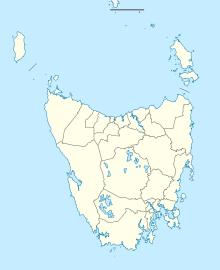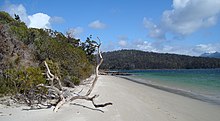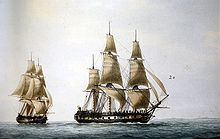Research Bay
Coordinates: 43 ° 32 ′ 52 ″ S , 146 ° 54 ′ 10 ″ E
Recherche Bay is a bay on the south coast of Tasmania in Australia. The bay is entered from the east. Recherche Bay is only about six nautical miles of the north southeast cape ( English South East Cape ) area, the extreme southern spur of Tasmania and the most southern point of Australia (apart from Antarctica part).
It was the first Tasmanian anchorage for Bruni d'Entrecasteaux's search expedition to find the missing explorer La Pérouse . It is named after one of the two ships on the expedition, the La Recherche . The other ship's name was L'Espérance, and a similar bay, about 18 nautical miles north-northeast, was named Port Esperance after the latter .
French exploration
The researchers built a small camp, garden, and scientific observatory on the shores of Recherche Bay. These facilities were used for 26 days in April 1792 and then again for 24 days in January 1793. Both visits were made to rest and replenish supplies, but a great deal of time was devoted to scientific research. The botanists Jacques Labillardière , Claude Riche and Étienne Pierre Ventenat collected, described and cataloged nearly 5000 plants including the blue eucalyptus ( Eucalyptus globulus ) which later became the herbal symbol of Tasmania. In 1793 the expedition also met the Tasmanian Aborigines who lived there and a friendly contact was established.
The Scientific Observatory in Recherche Bay was the site of the first planned scientific experiment on Australian soil. In this observatory, the geoscientist and later Rear Admiral Élisabeth-Paul-Édouard Rossel was able to carry out a series of tests that proved that the Earth's magnetic field changed with decreasing or increasing geographical latitude.
Settlement by the British
Recherche Bay was quite remote from the main settlement areas of Europeans in Tasmania and, due to its geographical location, was exposed to eastern storms. The difficult terrain and the nature of the soil deterred Europeans from agriculture. Therefore, the area around Recherche Bay was little affected by the British settlement of Van Diemen's land . During the 1830s and 1840s, a whaling station was established (as in Port Esperance, which is further north and protected). There was also a pilot station in Recherche Bay, whose pilots took the ships up the D'Entrecasteaux Channel and to Hobart. Whalers also later came sporadically to the bay to process whales, with two ships, the Maria Orr in 1846 and the Offley in 1880, being destroyed by storms in the bay. The main commercial activity in the late 1800s and 1990s was logging, mainly around the village of Leprena, and coal mining mainly around the village of Catamaran. The Catamaran Coal Company used the former James Craig barque as a coal hulk in the area.
Current controversy
In 2003, the private owners of the local forests sought permission to cut trees, which led to a large-scale campaign to protect the area from forest change.
In January 2006 the Tasmanian Land Conservancy announced plans to purchase the forests from the private owners for 1.3 million Australian dollars. Businessman Dick Smith donated AU $ 100,000 for the purchase.
Quote
“ It is difficult to describe my feelings in the face of this lonely harbor, located at an extreme point on the globe, so completely enclosed that you feel cut off from the rest of the universe. Everything is influenced by the wildness of the untamed landscape. At every step you can see the beauty of unspoiled nature, with signs of decay, trees that reach a very high height and have a corresponding circumference, without branches on the trunk, but crowned by everlasting green. Some of these trees seem as old as the world itself, and they are so intertwined that they are impenetrable. "
Individual evidence
- ^ "Australian Chart No. AUS 173, D 'Entrecasteaux Channel, Hobart to South East Cape “Ed. By Hydrographer of the RAN
- ↑ National Trust Endangered Places 2003 ( Memento of the original from July 19, 2008 in the Internet Archive ) Info: The archive link was inserted automatically and has not yet been checked. Please check the original and archive link according to the instructions and then remove this notice. accessed on January 5, 2006
- ^ Australian National Heritage listing for Recherche Bay accessed on July 9, 2008
- ↑ The exact locations of the French facilities on this expedition can be found at "www.recherchebay.org" under "Maps". See web links
- ↑ Bid to Buy Research accessed on January 20, 2006
- ↑ Dick Smith joins bid to protect Recherche Bay ( Memento of the original from March 12, 2007 in the Internet Archive ) Info: The archive link was inserted automatically and has not yet been checked. Please check the original and archive link according to the instructions and then remove this notice. accessed on January 24, 2006
- ↑ quoted from: Richard Landsdown: Romantic aftermaths. In: Peter Pierce (Ed.): The Cambridge History of Australian Literature. Cambridge University Press, Port Melbourne 2009. ISBN 0-521-88165-X
literature
- Bob Brown: Tasmania's Research Bay. Green Institute, Hobart Tasm 2005. ISBN 0-646-44899-4
- Edward Duyker, Maryse Duyker (ed. & Translator): Bruny d'Entrecasteaux. Voyage to Australia and the Pacific 1791-1793. Miegunyah / Melbourne University Press, Melbourne 2001. ISBN 0-522-84932-6
- Edward Duyker, Citizen Labillardière: A Naturalist's Life in Revolution and Exploration (1755-1834). Miegunyah / MUP, Melbourne 2003. ISBN 0-522-85010-3
- Edward Duyker: A French Garden in Tasmania. The Legacy of Félix Delahaye (1767-1829). Explorations, December 2004 (issued October 2005), pp. 3-18.
- Edward Duyker: Uncovering Jean Piron: In Search of d'Entrecasteaux's Artist. Explorations, December 2005 (issued June 2006), pp. 37-45.
- John Mulvaney, Hugh Tyndale-Biscoe (eds.): Rediscovering Recherche Bay. Academy of the Social Sciences in Australia, Canberra December 2007, p. 156. ISBN 0-908290-22-5
- John Mulvaney: 'The Ax Had Never Sounded': Place, People and Heritage of Recherche Bay, Tasmania . ANU E Press and Aboriginal History, Canberra 2007. ISBN 1-921313-20-X
- Bruce Poulson: Recherche Bay. A short history. 2nd ed. Southport Community Center, Southport 2005, p. 83. ISBN 0-9757975-0-6
- Danielle Clode: Voyages to the South Seas. In search of Terres Australes. Miegunyah / MUP, Melbourne 2007. ISBN 0-522-85264-5
- Cruising Yacht Club of Australia (Ed.): D'Entrecasteaux Waterways. Tasmanian Government Publication, Hobart 1990. ISBN 0-72462336-1


